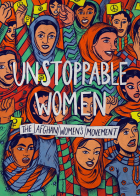1 - 10 of 10 Results
Date:
This report, “Content Analysis of Gender Representation in Advertising in China,” is an essential first step to identify how these media-driven stereotypes manifest in China and what can be done to address them. By shedding light on the urgent need for action, this report also contributes to the broader goals of the United Nations Sustainable Development Cooperation Framework (2021–2025
Date:
UN Women is closely examining the opportunities and challenges for lesbian, gay, bisexual, transgender, gender diverse, intersex, and queer (LGBTIQ+) persons’ full equality and inclusion in electoral processes in 2024 and beyond.
Date:
This submission on electoral participation and sexual orientation and gender identity closely examines the opportunities and challenges for lesbian, gay, bisexual, transgender, gender diverse, intersex, and queer (LGBTIQ+) persons’ full equality and inclusion in electoral processes.
Date:
UN Women Afghanistan commissioned this graphic novel, co-produced by Afghan women, to bring to life Afghan women’s powerful advocacy and incredible resilience in the most oppressive circumstances. Stories of loss reverberate throughout Afghanistan. But there is also hope even in the face of such loss. Afghan women don’t accept the restrictions imposed on their rights. Afghan women will not give up. They are unstoppable.
Date:
This report focuses on media, marketing, and advertising's role in perpetuating stereotypes and provides practical solutions for a more equitable future. It delves into how gender norms are encoded in TV shows, films, and advertising creative content.
Date:
The aim of the dialogue was to find areas of collaboration to promote the gender equality and women’s empowerment (GEWE) narrative through media.
Date:
The brief concluded that the indirect ramifications of dismissing women staff in the media sector removes them from public space, contributing to the retreat of women into domestic environments. The justification underpinning this retreat is often that of protecting women, which normalizes the narrative that women are inherently vulnerable and require protection, erasing their agency and vital contribution to a pluralistic society.
Date:
It cannot be stressed enough that violence against women and girls continues to be one of the most pervasive human rights violations in the world. It acts as both a cause and a consequence of gender inequality, and ranges in impact from adverse effects on the health, safety, productivity and overall well-being of women and girls, to impeding the realization of their rights and contribution to society at large. Despite decades of concerted efforts, at the global, regional and local levels.
Date:
These guidelines are intended to promote best practices for responsible, ethical and safe representation and reporting of violence against women (VAW) and violence against children (VAC) by media practitioners. While the causes, risk factors, prevalence, patterns and consequences of violence against women and violence against children may differ, many of the considerations for ethically, safely and effectively communicating these issues are crosscutting.
Date:
The second issue of UN Women Asia-Pacific covers; - Updates from Nepal recovery works , - The launch of POWW report in Asia-Pacific, - HeForShe activities in the region and much more updates from country offices across Asia and the Pacific

![[cover]](/sites/default/files/styles/search_image_140px/public/2025-03/cn-20250380578-content-analysis-of-genderrepresentationinadvertisingin-china-960px.jpg?itok=1vhCHp8l)


![[cover]](/sites/default/files/styles/search_image_140px/public/2023-08/ap-Dismantling-Gender-Stereotypes-in-media-960px.jpg?itok=ytZfhdRA)
![[cover]](/sites/default/files/styles/search_image_140px/public/2023-02/bd-DIALOGUE-WITH-MEDIA-960px.jpg?itok=4inFxMid)
![[cover]](/sites/default/files/styles/search_image_140px/public/2022-10/afg_Periodic-Briefing-no1_Media_Oct22-960px.jpg?itok=qL3o0ch6)
![[cover]](/sites/default/files/styles/search_image_140px/public/Field%20Office%20ESEAsia/Images/2021/11/ap-TheBigConversation-MediaHandbook-compressed-1679px.jpg?itok=hzEAzB87)
![[covers]](/sites/default/files/styles/search_image_140px/public/Field%20Office%20ESEAsia/Images/2020/12/ap-Responsible-representation-and-reporting-VAW.jpg?itok=pdvfh4gF)
